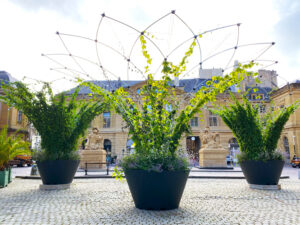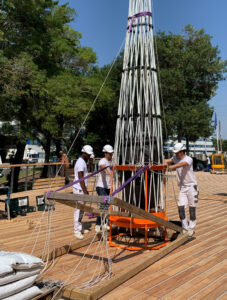
The tree you have when you’re not having a tree!
By Gabrielle Stannus
Halfway between a shade sail and a tree, the Canopee is an innovative form of green infrastructure designed to increase canopy cover and mitigate the impact of climate change in our urban concrete jungles. Of French origin, the use of these structures is now ‘growing’ across Australia.
This unique design connects building/architecture with the landscaping industry to create a new solution. With the urban heat island effect being a concern for people and little available space to plant trees, they may provide a practical solution to some place-makers.
French design – Ooh la la!
The Canopee, a lightweight and self-contained solution to green any place where trees cannot be planted. It is a modular, funnel-shaped trellis structure made from interconnected composite glass fibre rods that essentially replicates the shape of a tree. “Our disruptive innovation is based on four patents, and 15 years of advanced research and development in France on the materials and advanced calculations of lightweight structures,” says Germain Briand, Managing Director of Urban Canopee Australia. Both the structure itself and the unique connectors are patented.
The structure is designed according to biophilic principles. “Point number one is bringing green where green cannot be brought in, in a traditional manner, so that in itself is biophilic design,” explains Germain, “Now it turns out that nature works on mathematics. The shape also comes from mathematics and is very much a shape that is found in the natural world. That too is a biophilic design principle, to build with shapes reminiscent of the natural world. I always give the example of the Sydney Opera House. Why do most people fall in love with it? Well, it is a unique building, but its shape also goes straight to your subconscious, drawing us to its nature-based shape.”
The standard structure is just under five metres in height and has an average weight of around 900kg with plants. This structure comes with a built-in water reservoir and a choice of optional extras such as bench seating, high bar tables, misting or lighting. This solution takes up minimum footprint on the ground (~1m2) whilst providing up to 50m2 of canopy cover. The smaller version is just over three meters in height, weighs around 255kg with plants, and provides a canopy cover up to 20m2.

Low fuss, pollution-free installation
Whilst these structures have been installed in Australia using forklifts, elevated work platforms (EWPs) and even an excavator, they can be put into place without that type of machinery. In France, contractors use a counter lever with ropes to lift them into position, requiring only the use of human power. “There is an environmental message behind this process as we do not want to use diesel driven equipment on site, given the greenhouse gas emissions it produces,” explains Germain.
Installation normally takes less than one day as water and electrical mains connection are not required. They have a smart irrigation system built into the structure, and are powered by a solar panel to ensure that the plants are watered just the right amount at the right time.
Climbing plants are the go
Containerised plants mean that installation has no impact on underground services. “What we are looking for is a climbing plant that is going to establish itself nice and quickly and that will anchor itself well on the structure,” explains Germain, “The plant needs to grow to the sufficient height and width with the foliage thickness to cover the entire structure.” Polygonum aubertii (Russian Vine) has been successful in France, although Germain thinks this fast-growing climber might become invasive in some parts of Australia. So, they are trialling Clematis montana and Akebia quinata (Chocolate Vine) on their Australian structures.
Substrate akin to a green roof mix
Plants are planted in a lightweight substrate supplied by Australian Growing Solutions. This substrate has a physical structure that holds up over time, maintaining air-filled porosity and water holding capacity like those growing media used on green roofs. “A challenge that we have over time is to ensure that the substrate does not compact too much because it is kind of tricky to add more at a later stage once you have got an established foliage around the structure,” explains Germain, “We are undertaking research and development in France to determine how the plants respond to different types of substrates. In time, we will develop our own substrates, as well as our own fertilisers.”

Location, location, location!
These structures are typically installed in built-up locations experiencing the urban heat island effect along with high pedestrian traffic. They have been erected at schools, shopping centres, hospitality venues, swimming pools, hospitals and aged care facilities in over 60 cities in Europe and Australia. The first and largest project in Australia to install the structures is in Cootamundra in central New South Wales, where four were raised in an urban streetscape. They have also been installed in the City of Brimbank, the Melbourne suburb of Alphington, a pub in Newcastle, a school in Altona and are soon to go into Adelaide. These structures have also been used to temporarily activate places within Melbourne’s QV Shopping Centre and the Sydney Olympic Park.
Whilst these structures may not be able to sequester as much carbon as a traditional tree, (initial high-level analysis however shows that a structure is expected to become carbon positive after 5.5 years), they are worthy of consideration in urban spaces where access to healthy soil is just not available and street cooling is desperately required. Given their unique aesthetics and attributes, they also make a site more visually appealing and attractive, potentially turning that space into a place that people want to visit.
Gabrielle Stannus
Inwardout Studio
M: 0400 431 277
